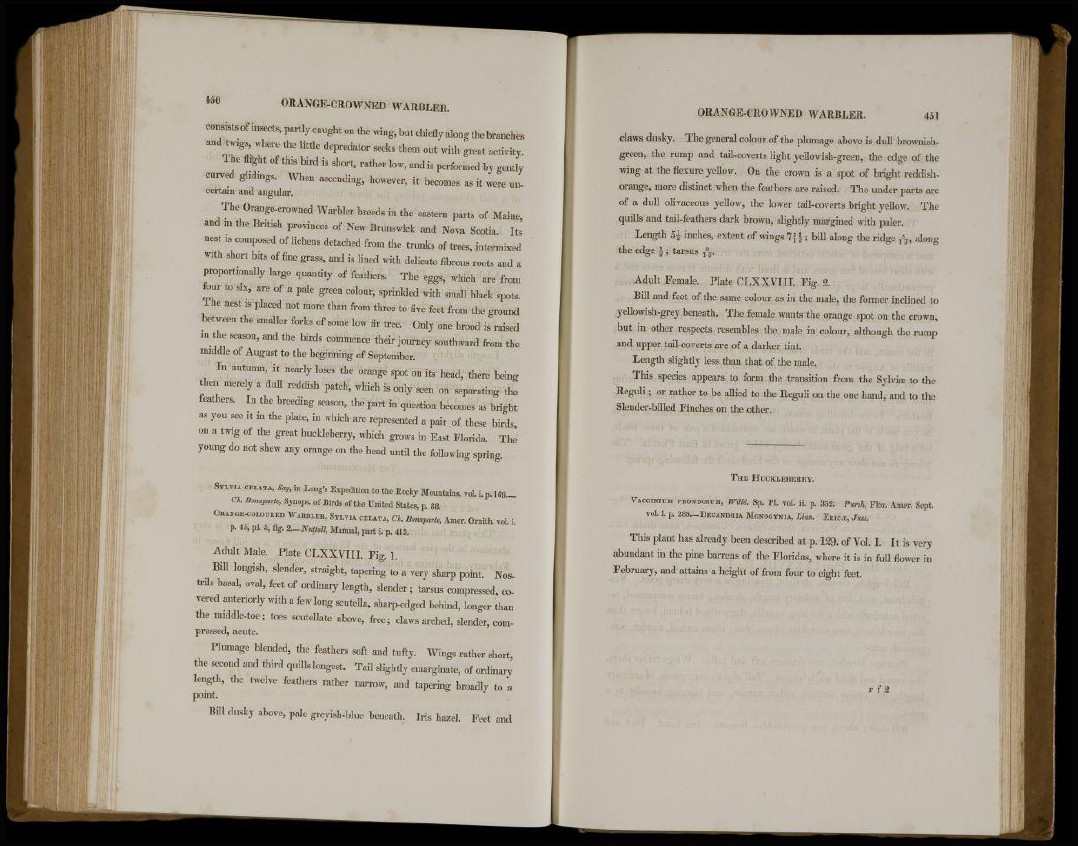
450 ORANGE-CROWNED WARBLER.
consists of insects, partly caught on the wing, but chiefly along the branches
and twigs, where the little depredator seeks them out with great activity.
The fli'ght of this bird is short, rather low, and is performed by gently
curved glidings. When ascending, however, it becomes as it were uncertain
and angular.
The Orange-crowned Warbler breeds in the eastern parts of Maine,
and in the British provinces of New Brunswick and Nova Scotia. Its
nest is composed of lichens detached from the trunks of trees, intermixed
with short bits of fine grass, and is lined with delicate fibrous roots and a
proportionally large quantity of feathers. The eggs, which are from
four to six, are of a pale green colour, sprinkled with small black spots.
The nest is placed not more than from three to five feet from the ground
between the smaller forks of some low fir tree. Only one brood is raised
in the season, and the birds commence their journey southward from the
middle of August to the beginning of September.
In autumn, it nearly loses the orange spot on its head, there being
then merely a dull reddish patch, which is only seen on separating the
feathers. In the breeding season, the part in question becomes as bright
as you see it in the plate, in which are represented a pair of these birds,
on a twig of the great huckleberry, which grows in East Florida. The
young do not shew any orange on the head until the following spring.
SYLVIA CELATA, Say, in Long's Expedition to the Rocky Mountains, vol. i. p. 169.—
Ch. Bonaparte, Synops. of Birds of the United States, p. 88.
OKANGE-COLOURED "WARHLER, SYLVIA CELATA, Ch. Bonaparte, Amer. Ornith. voL i.
p. 45, pL 5, fig. 2.—Nut tall, Manual, part i. p. 413.
Adult Male. Plate CLXXVIII. Fig. 1.
Bill longish, slender, straight, tapering to a very sharp point. Nostrils
basal, oval, feet of ordinary length, slender; tarsus compressed, covered
anteriorly with a few long scutella, sharp-edged behind, longer than
the middle-toe; toes scutellate above, free; claws arched, slender, compressed,
acute.
Plumage blended, the feathers soft and tufty. Wings rather short,
the second and third quills longest. Tail slightly emarginate, of ordinary
length, the twelve feathers rather narrow, and tapering broadly to a
point.
Bill dusky above, pale greyish-blue beneath. Iris hazel. Feet and
claws dusky. The general colour of the plumage above is dull brownishgreen,
the rump and tail-coverts light yellowish-green, the edge of the
wing at the flexure yellow. On the crown is a spot of bright reddishorange,
more distinct when the feathers are raised. The under parts are
of a dull olivaceous yellow, the lower tail-coverts bright yellow. The
quills and tail-feathers dark brown, slightly margined with paler.
Length 5^ inches, extent of wings 7 J §; bill along the ridge ft, along
the edge | ; tarsus T
9
5 .
Adult Female. Plate CLXXVIIL Fig. 2.
Bill and feet of the same colour as in the male, the former inclined to
yellowish-grey beneath. The female wants" the orange spot on the crown,
but in other respects resembles the male in colour, although the rump
and upper tail-coverts are of a darker tint.
Length slightly less than that of the male.
This species appears to form the transition from the Sylvia) to the
Reguli; or rather to be allied to the Reguli on the one hand, and to the
Slender-billed Finches on the other.
THE HUCKLEBERRY.
"VACCINIUM FROJTDOSUM, Willd. Sp. PI. vol. ii. p. 352; Pursh, Flor. Amer. Sept.
vol. i. p. 285.—DECANDRIA MONOGYNIA, Linn. ERiCiE, Juss.
This plant has already been described at p. 129. of Vol. I. It is very
abundant in the pine barrens of the Floridas, where it is in full flower in
February, and attains a height of from four to eight feet.
F f 2